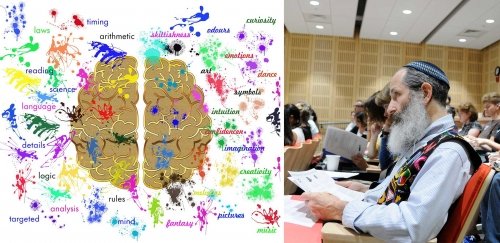Universal Design for Learning and the Arts: A Seminar at RIC
- News & Events
- News
- Universal Design for Learning and the Arts: A Seminar at RIC

Neuropsychologists have found that right-brain people have different skills and preferences than those who are left-brain. Universal Design for Learning is a framework for instruction that taps both sides of the brain.
Art educators from K-12 schools, colleges and community arts programs throughout Rhode Island recently gathered at RIC’s ALEX AND ANI Hall for a professional development workshop titled “Arts & Universal Design for Learning (UDL),” an internationally recognized framework for curriculum design.
The sold-out event was initiated by Jeannine Chartier, executive and artistic director of VSA Arts Rhode Island, and sponsored by Rhode Island College, The Kennedy Center/VSA, the Rhode Island State Council on the Arts (RISCA), the Rhode Island Foundation and the Rhode Island Teaching Artists Center.
The workshop began with an opening keynote by Elizabeth Dalton, director of development and research at TechACCESS of Rhode Island (technology services for people with disabilities). Dalton defined UDL as a way of designing curricula to engage all learners.
Dalton has worked in the disability field for almost 40 years. A focus on accessibility is what first drew her to UDL, she said.
UDL is based on research in neuropsychology and how the brain processes information. Neuroscience shows that individuals learn in different ways. Therefore, teachers must approach instruction in ways that facilitate learning among the broadest range of students.
Differences between learners can manifest in myriad ways: individuals may have a range of educational backgrounds, learning difficulties and language barriers.
To reach the maximum amount of learners, teachers must recognize this diversity and create flexible learning environments that incorporates the following UDL criteria:
- Providing multiple means of engaging students.
- Providing multiple means of presenting material.
- Providing multiple ways for learners to express or show what they have learned and for teachers to assess what they have learned.
“One size does not fit all,” Dalton emphasized, and said it is important that assessments work for everyone. In the same classroom, there may be students with learning difficulties, students who are gifted and students in the middle of that polarity. “How can we assess them the same, using the same general standards?”
To design a course using UDL, teachers “can start with any academic goal, including the general standards, and then vary the methods, materials and assessments,” said Dalton.
A teacher may have students verbally restate what they have learned or pair up with their peers to demonstrate what they have learned or relate the lessons to their lives.
Creativity plays a large role in UDL, which was demonstrated in four workshops following Dalton’s keynote. Attendees were asked to participate in a dance, music, theater or visual/media arts workshop that demonstrated the creative ways in which UDL can be built into all the art disciplines.
Highlights of the workshops were performed by members of each group, followed by a panel discussion moderated by Randall Rosenbaum, executive director of RICSA and included the following panelists:
- Amy Grattan, master teacher, Paul V. Sherlock Center on Disabilities.
- Susan Sward, visual arts educator, West Warwick public schools.
- Jessica Hassell, special education educator, West Warwick public schools.
- Tom DiPaola, director, Ph.D. program in educational leadership at Johnson and Wales University.
- Henry Fiore, principal, St. Pius School, Westerly.
The closing keynote was presented by Rachel Balaban, cofounder and codirector of Artists and Scientists as Partners at Brown University, where she teaches dance to people with Parkinson's Disease and other movement disorders. Balaban also created DAPpers (Dance for the Aging Population) at Brown University.
In sum, the daylong event provided a theoretical framework and experiential opportunities, leaving attendees with information and tools to develop new programs or to build upon existing programs in their respective areas.
